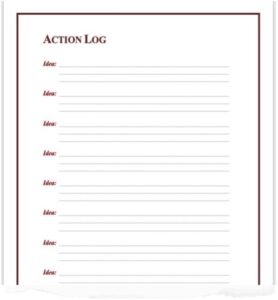 Imagine a scenario for a moment: You’re attending a one or two-day seminar that you’ve been looking forward to. The agenda looks just like what you’ve been hoping for, and you sit down with pen, pad, and highlighter in hand. The instructor seems to be reading your mind, because waiting for you at your seat is a nice, big participant guide! You’re not going to miss a thing!
Imagine a scenario for a moment: You’re attending a one or two-day seminar that you’ve been looking forward to. The agenda looks just like what you’ve been hoping for, and you sit down with pen, pad, and highlighter in hand. The instructor seems to be reading your mind, because waiting for you at your seat is a nice, big participant guide! You’re not going to miss a thing!
The program begins, and as the minutes tick by, the material is exceeding your expectations. It seems a lot of thought was put into the creation of this workshop, and with so much great material being delivered, between your highlighting, and note taking, that participant guide of yours is getting a real workout!
When the program is completed, you couldn’t be happier. Over the course of two days, you didn’t just find an idea or two, you found an avalanche of ideas you can’t wait to put to use! You smile all the way home… until the next morning when you open your participant guide and begin to look over your notes. Jubilation turns to confusion as you try and decipher what you written, and then confusion turns to frustration as you try to find, in your sea of notes, the critical pieces of information you were hoping to implement.
Does that scenario sound familiar? If you’ve ever attended a great seminar, it should.
I’m not going to blame the instructor, because you weren’t given a ridiculous copy of PowerPoint slides or a blank pad of paper; you were given a participant guide tracking the presentation. You weren’t a victim of a poor delivery, or a poor documentation or even too much information. Ironically, you were the victim of a powerful seminar.
Some years ago, I ran into this particular issue in one of the workshops I was delivering. It was a Train-the-Trainer program, and like many programs, different pieces applied to different participants. Initially, I tried inserting designated note-taking areas blocked on multiple pages while giving a short explanation of how to take notes within the participant guide. It didn’t work, but I’ll tell you what did.

Sample Action Log
It dawned on me that the real problem wasn’t the lack of note-taking, but rather trying to detect the need to remember items from the nice to remember items. I began to insert a page in the front of each participant guide that I called an “Action Log.” I explained its purpose to the attendees by saying: “I’m sure you’ll find the material I’m about to deliver of value, but every now and then, you’re going to hear something that you think will be absolutely perfect for what you do, and you’re going to want to make sure you remember it. Use your Action Log to capture those particular ideas so they will be easy to access when you return to your offices. In short, if you plan on implementing certain ideas when you return, capture those ideas here.” It worked like a charm!
There’s an old adage that states this: “If you emphasize everything, you emphasize nothing.” That applies to those of us who teach others, but it also applies to those who attend the programs we deliver. By supplying an Action Log, and an explanation of how to use it, you’ll help others to not only learn from your words, but to also implement the key pieces that apply to them as well.
 What do you get when combine energy, enthusiasm… and great content? You get a “Pocket Sized Pep Talk,” and there are now over 275 of them! Tune in and you’ll hear a collection of conversations, interviews, and even some BLArticles® that are sure to teach, motivate, inspire, and oh yes; entertain! https://podcasts.apple.com/us/podcast/pocket-sized-pep-talks/id1497772972
What do you get when combine energy, enthusiasm… and great content? You get a “Pocket Sized Pep Talk,” and there are now over 275 of them! Tune in and you’ll hear a collection of conversations, interviews, and even some BLArticles® that are sure to teach, motivate, inspire, and oh yes; entertain! https://podcasts.apple.com/us/podcast/pocket-sized-pep-talks/id1497772972
 What’s better than one sales trainer? Well, two of course! Join us every other Tuesday for our LinkedIn Live Series at 12:30 pm EST when we bat around different ideas in what we’re calling: “What to say when a prospect says…?” Our most recent tips related to, “What to say when a prospect says, I don’t believe you.”
What’s better than one sales trainer? Well, two of course! Join us every other Tuesday for our LinkedIn Live Series at 12:30 pm EST when we bat around different ideas in what we’re calling: “What to say when a prospect says…?” Our most recent tips related to, “What to say when a prospect says, I don’t believe you.”

Spot on, my friend/ I also anchor some learning points with a gesture and get the audience to repeat the gesture. Amazing how that sticks
Love it! I’ve tried the classics: Repeat it – Make it visual – Get the audience to “do” what I’m teaching. All work well, but when we get into eight and sixteen hour workshops there’s a lot to remember. We have to be careful not to fall into the trap of putting too much into a program, and then find ways to help attendees capture what’s most important to THEM. Thanks for posting Eileen!
Thanks Rob. Excellent idea for end users. I’m using your idea for my next presentation.
It’s particularly useful when you have a delivery that lasts for at least half a day. Good ideas just start backing up. Thanks for posting Ruth!
Thanks Rob. This is a great tip! Finding ways to help the audience is fundamental.
Funny you should say that because I firmly believe, just about every decision we make centers on what’s best for the audience. Plain and simple. We try not to put too much into a presentation, but when a well-timed workshop has an abundance of great ideas, the Action Log will help them find them when they return home to implement what has been taught. Thanks for posting Hui!